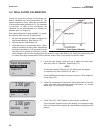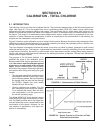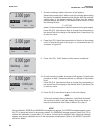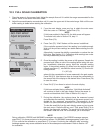
MODEL 54eA SECTION 10.0
CALIBRATION - MONOCHLORAMINE
SECTION 10.0
CALIBRATION - MONOCHLORAMINE
65
10.1 INTRODUCTION
As Figure 10-1 shows, a monochloramine sensor generates a current directly proportional to the concentration of
monochloramine in the sample. Calibrating the sensor requires exposing it to a solution containing no monochlo-
ramine (zero standard) and to a solution containing a known amount of monochloramine (full-scale standard).
The zero standard is necessary because monochloramine sensors, even when no monochloramine is in the
sample, generate a small current called the residual or zero current. The analyzer compensates for the resid-
ual current by subtracting it from the measured current before converting the result to a monochloramine value.
New sensors require zeroing before being placed in service, and sensors should be zeroed whenever the elec-
trolyte solution is replaced. The best zero standard is deionized water.
The purpose of the full-scale standard is to establish the slope of the calibration curve. Because stable mono-
chloramine standards do not exist, the sensor must be calibrated against a test run on a grab sample of the
process liquid. Several manufacturers offer portable test kits for this purpose. Observe the following precautions
when taking and testing the grab sample.
• Take the grab sample from a point as close to the sensor as possible. Be sure that taking the sample does not
alter the flow of the sample to the sensor. It is best to install the sample tap just downstream from the sensor.
• Monochloramine solutions are unstable. Run the test immediately after taking the sample. Try to calibrate
the sensor when the monochloramine concentration is at the upper end of the normal operating range.
FIGURE 10-1. Sensor Current as a Function of Monochloramine Concentration


















